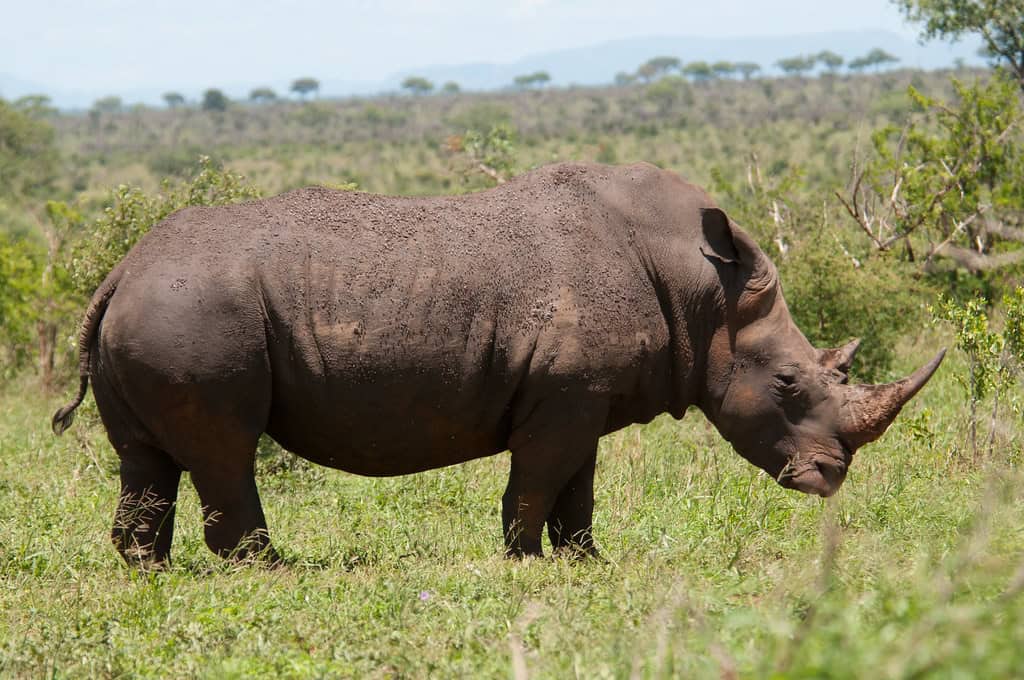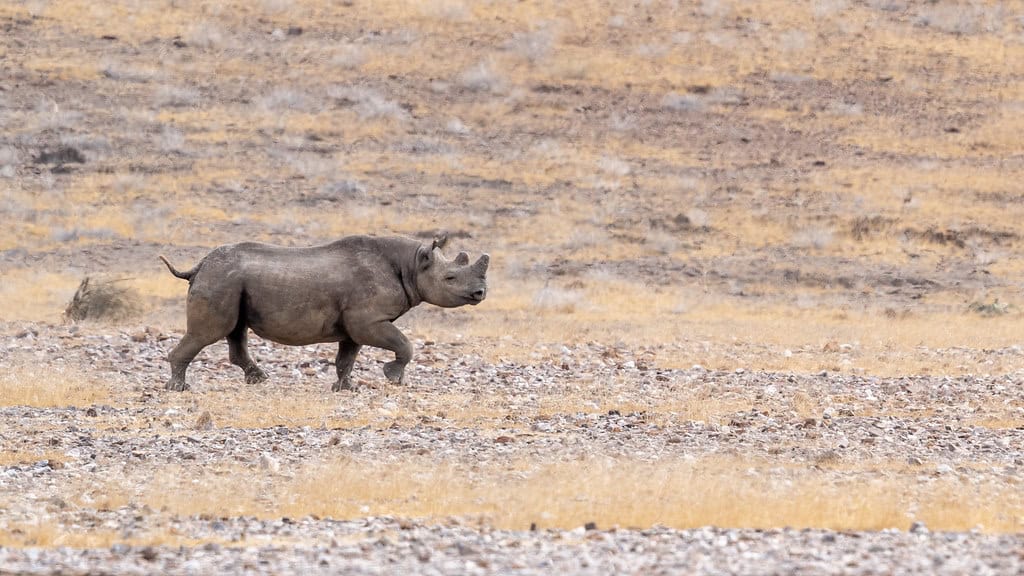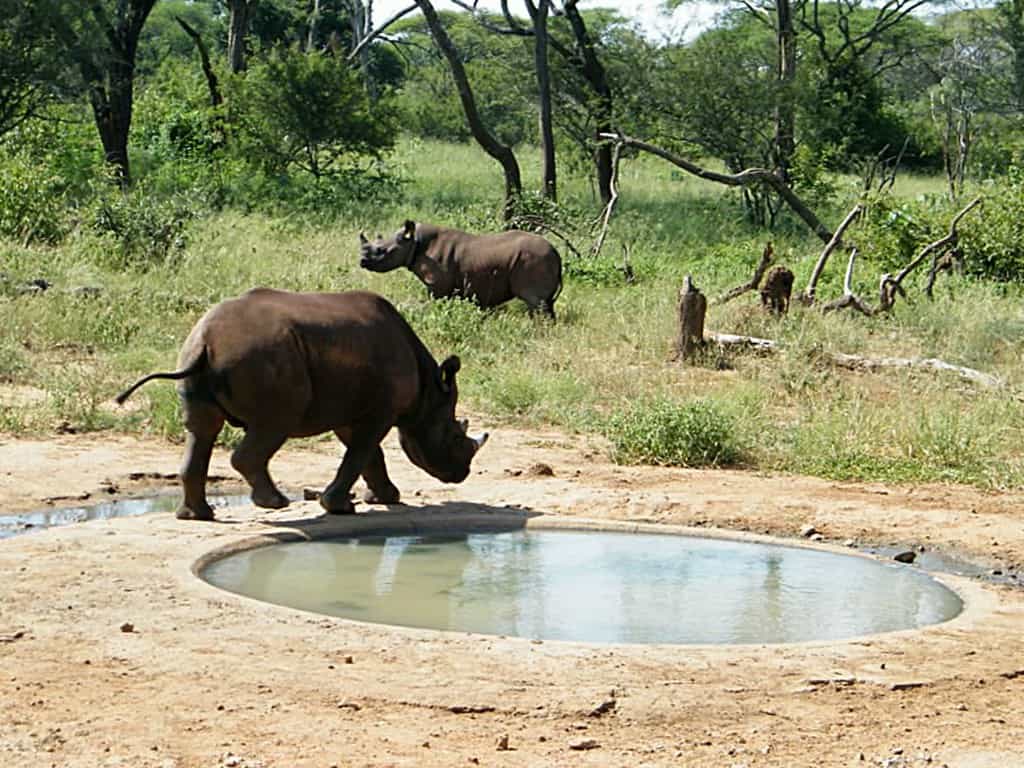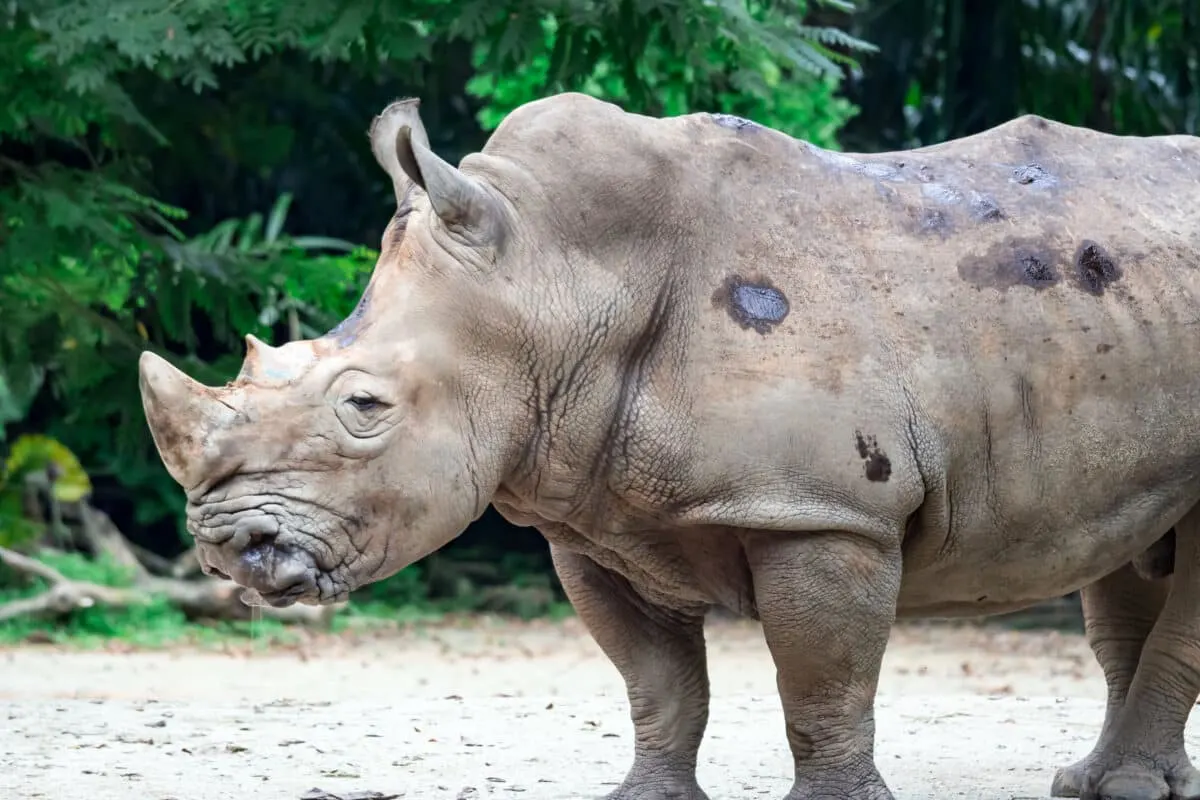Imagine standing in the golden savanna as the sun breaks the horizon, and suddenly you hear the thunderous steps of a creature that survived the age of dinosaurs. Your heart pounds as you realize you’re about to witness one of nature’s most magnificent and endangered giants. There are fewer than 30,000 rhinos left in the wild today, making every sighting incredibly precious. These ancient armor-plated beasts once roamed across vast continents, but now they’re confined to just a handful of protected sanctuaries where dedicated conservationists fight daily to keep them alive. Whether you’re dreaming of tracking black rhinos through Namibian deserts or watching white rhinos graze in South African reserves, the opportunity to see these incredible animals in their natural habitat is both a privilege and an urgent reminder of what we stand to lose forever.
Kruger National Park, South Africa

South Africa’s flagship national park, Kruger National Park, has by far the largest population of rhinos in Africa, with both black and white rhinos calling this vast wilderness home. Your best chance of seeing rhino is in the southern part of the park where white rhinos are commonly spotted. While not as well known, you’ll need more luck to spot the smaller black rhino, a browser that tends to lurk unobtrusively in dense thickets. The park spans nearly 20,000 square kilometers, making it larger than some countries, and its diverse ecosystems support an incredible variety of wildlife. All of the ‘big five’ game (rhinos, elephants, buffalo, leopards and lions) can be found in the park, as can giraffes, zebras and wildebeest, with the area filled with natural beauty and safaris widely available. The infrastructure here is excellent, with multiple camps offering everything from basic camping to luxury lodges, making it accessible for visitors with different budgets and comfort preferences.
Etosha National Park, Namibia

Etosha National Park is said to be one of the best locations, not only in Namibia, but the world for game-viewing, making it the perfect location to catch a glimpse of rhinos in the wild and a premier destination for anyone wanting to see wild rhinos. Though it is usually encountered in thick vegetation, the black rhino also thrives in the open desert environs of Namibia’s Etosha Pan, with sightings of this rare prehistoric animal being common here. Etosha National Park is known for its incredible wildlife viewing at waterholes in the Dry season, so try the floodlit Okaukuejo waterhole at night; with patience, you might see a solitary black rhino come to drink. As well as black rhinos, the area is home to ostriches, leopards and some of the largest elephants in all of Africa, with hundreds of species of reptiles, birds and game found in the 8,600 square mile area. The park’s unique landscape, dominated by a massive salt pan visible from space, creates an almost otherworldly setting that makes wildlife encounters feel even more dramatic and memorable.
Ol Pejeta Conservancy, Kenya

The not-for-profit 90,000-acre Ol Pejeta Conservancy has the largest population of black rhino in East Africa; over 100. Housing over 165 highly endangered black rhino and 44 southern white rhino, Ol Pejeta Conservancy offers plenty of opportunities to see rhino in their natural habitat. The conservancy was also home to Sudan, the last male northern white rhino, before he died, and where you’ll find the last two northern white rhinos still alive, both females, with hopes they will provide a breeding population with Sudan’s semen, saved for posterity. The conservancy prides itself on safeguarding the critically endangered rhino, alongside other vulnerable species like the African wild dog, cheetah, lion, Grevy’s zebra and Jackson’s hartebeest. What makes Ol Pejeta particularly special is its combination of conservation success and visitor accessibility, with excellent accommodations and day visitor options. In addition to traditional game-viewing and the opportunity to see the Big Five, visitors to Ol Pejeta Conservancy are spoiled with a variety of additional interactive conservation-driven activities.
Hluhluwe-Umfolozi Park, South Africa

While not as well known, Hluhluwe-Umfolozi Park in Kwa-Zulu Natal is the oldest nature reserve in Africa and certainly one of the best for wildlife viewing. It was established in the 1890s as a sanctuary for what was then the country’s last remaining population of southern white rhino, and it is where rhino conservation began and where this incredible creature was narrowly saved from extinction. Today, both black and white rhino are common, although the former is easy to miss in the dense vegetation. This park has a remarkable conservation legacy that goes back over a century, making it one of the most historically significant rhino sanctuaries in the world. The rolling hills and diverse vegetation create perfect habitat for rhinos, and the park’s commitment to conservation research has been instrumental in developing modern rhino protection techniques. Visitors often describe the experience here as more intimate and authentic compared to some of the larger, more commercialized parks, with excellent opportunities for both game drives and guided walks.
Kaziranga National Park, India

Only 600 one-horned rhinos remained in Asia in 1975, but now, thanks to strict protection from Indian and Nepalese wildlife authorities, these numbers have increased to between 3,500 to 3,600, with around two thirds of these living in Assam’s magical Kaziranga National Park. You are almost guaranteed to see one-horned rhinos on the open plains here and you can see the Jurassic-like creatures either on a jeep or elephant safari. Kaziranga, bordered in the north by the Brahmaputra River, is a mix of forest grassland, marsh and pools, and it floods in summer during the monsoon – the river bursts its banks – and 2012 was a particularly tough year, with some rhinos lost to high floodwaters and poaching. Going between November and February, when the climate is mild and dry will increase your chances of spotting rhino. The park has a significant tiger population too and its name has been extended to include ‘Tiger Reserve’, though you’d be very lucky to spot one in the tall elephant grass. The wetland ecosystem here is completely different from African rhino habitats, offering visitors a unique perspective on how these magnificent creatures have adapted to different environments.
Damaraland, Namibia

Named after the Damara People, who reside in the area, Damaraland is widely considered to be one of the most picturesque areas in Namibia, with this untouched natural paradise providing a jaw-dropping backdrop for game viewers looking to lay their eyes upon the rare black rhino and presenting a multitude of opportunities to see other rare animals during your trek. Uniquely, the south-western black rhino of the Kunene region are desert-adapted, covering huge areas, climbing mountains and drinking only every few days. This region is marked by its tranquil, minimalist beauty, surprising numbers of desert-adapted wildlife, and the world’s largest free-roaming population of the critically endangered black rhino, with SRT being the leading organization working to protect the desert-adapted black rhino of the Kunene and Erongo regions, where hunting and poaching had almost eradicated their populations in the arid regions, but since the 1980’s the population of these magnificent animals has increased five times! The area has multiple accommodation options, including eco-tourism camps and luxury lodges, and there are multiple safari trips on offer which are delivered by expert guides, with the best time to go to this amazing part of the world being between July and October, as wildlife viewing is best during these months.
Matusadona National Park, Zimbabwe

There are a few black rhinos in the park as well. One of the unique features of Matusadona is its black rhino population, which can be tracked on foot in a controlled and guided manner. A protected area, Matusadona has healthy populations of black rhino. If I was wanting to see Black rhino, I would want to see them in the wild if at all possible and as far as Zimbabwe goes, Matusadona is the place where you have the best chance of doing this, with The Zambezi Society and Save the Rhino International reporting a ‘good and growing’ Black rhino population in Matusadona (an Intensive Protection Zone) with only one rhino having been lost in the area to poachers since 2000. This unique park sits on the shores of Lake Kariba, offering a completely different rhino viewing experience where water-based activities complement traditional game drives. The combination of lake, mountains, and savanna creates diverse habitats that support not only rhinos but also large elephant herds, buffalo, and over 240 bird species, making it a true wilderness adventure.
Okavango Delta, Botswana

Botswana has seen less rhino poaching than many of its neighbours and indeed many rhino have been relocated from South Africa to Botswana for safety at huge cost, with conservation charities, such as Rhinos Without Borders, together with camp operators including &Beyond and Great Plains, having relocated 87 rhino from South Africa to Botswana (as at December 2019). The Okavango Delta is home to some of the world’s most endangered species of large mammals, such as the white rhinoceros and black rhinoceros too. In the Okavango Delta, black rhinos are occasionally encountered in Moremi Game Reserve – particularly in the mopane woodland to the east, however, numbers are very low and a sighting should be considered exceptional, with the ongoing reintroduction programme and improved security meaning numbers should rise, making sightings more likely in future. At Okavango Delta, Rhinos are often found in the private concessions, with these areas being less crowded and providing a good experience. The Delta’s unique water-based ecosystem offers visitors the chance to combine rhino viewing with mokoro (traditional canoe) trips and boat safaris, creating an unparalleled African adventure. While rhino sightings aren’t guaranteed here, the overall wildlife experience is so extraordinary that many consider it worth the visit regardless.
Mkhaya Game Reserve, Swaziland

Mkhaya Game Reserve in the south-east is rugged bushland dotted with thorn trees, which makes it probably your best chance of seeing black rhino in the wild in Africa, where you can get intimately close with a guided tour on foot, and you’ll also see elephant, hippo, buffalo and birds. Both reserves have varied accommodation options and offer excellent value for money compared to many African parks and reserves. This smaller, more intimate reserve offers what many consider to be the most authentic black rhino viewing experience available anywhere in Africa. The thick bushveld terrain here perfectly mimics the natural habitat that black rhinos prefer, and the reserve’s commitment to conservation has created a safe haven where these magnificent creatures can thrive. Walking safaris here provide an unmatched adrenaline rush as you track rhinos on foot with experienced guides, getting closer to these prehistoric giants than you’d ever imagine possible. The reserve’s remote location and limited visitor numbers ensure that your encounter with rhinos feels genuinely wild and untouched by mass tourism.
Ujung Kulon National Park, Indonesia

Javan rhinos are the most threatened of the five rhino species, with only around 76 individuals that live only in Ujung Kulon National Park in Java, Indonesia. Indonesian officials have reported the sighting of a new Javan rhino calf in Ujung Kulon National Park, home to the last surviving population of the critically endangered species. The Javan rhinoceros is known to survive in only one place, the Ujung Kulon National Park on the western tip of Java, and today, it is the rarest of all rhinoceros, and among the rarest of all living animal species, with only one currently known wild population, and no individuals successfully kept in captivity, with a population of approximately 74 rhinos within Ujung Kulon National Park. Though visitors did not manage to spot the elusive endangered and rare Javan one-horn rhino, they saw many Pied Hornbills in flight, Javan Wild oxen grazing, even indolent python at close range, with the highlight of the park being to see a great variety of ecosystems from coral reefs, rugged coastlines and tranquil sandy beaches with nipa palms, strangling figs, mangrove swamps, pandanus groves and other plants of the lowland rainforest and tropical coastal beach. This UNESCO World Heritage Site represents your only chance to see the world’s rarest rhino species, though sightings are extremely difficult due to the dense jungle habitat and the rhinos’ elusive nature. It’s very difficult to see the Rhinos (the jungle is… well the jungle, super dense) and visitors often don’t see them.
Conclusion

These ten destinations represent the last strongholds where wild rhinos still roam free, each offering a unique window into the lives of these ancient giants. From the open savannas of Kruger to the dense jungles of Ujung Kulon, every location tells a different story of survival, conservation, and hope. The diversity of experiences available is remarkable – you can track desert-adapted rhinos on foot in Namibia, watch one-horned rhinos grazing in Indian wetlands, or cruise through Botswana’s waterways hoping for a glimpse of a relocated rhino family. What unites all these places is the incredible dedication of rangers, conservationists, and local communities who work tirelessly to protect these magnificent creatures. Each rhino you might encounter represents decades of conservation effort, international cooperation, and sometimes heartbreaking setbacks. Whether you’re lucky enough to see a mother with her calf in Kenya or witness a massive white rhino bull in South Africa, you’re participating in something much bigger than wildlife viewing – you’re supporting the fight for survival of one of Earth’s most iconic species. Can you imagine a world where future generations might only see rhinos in old photographs?
- How the Bald Eagle Bounced Back from Near Extinction in the US - August 11, 2025
- This Transparent Fish Has a Completely SeThrough Head And It is Fascinating - August 11, 2025
- 12 Dog Breeds With the Best Sense of Smell - August 11, 2025

